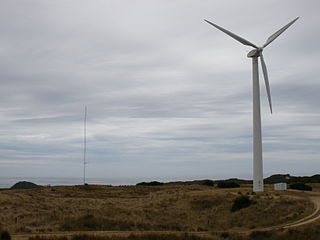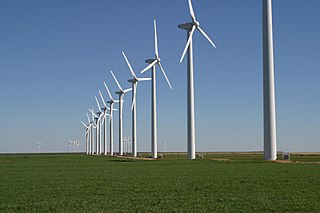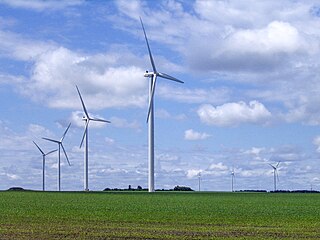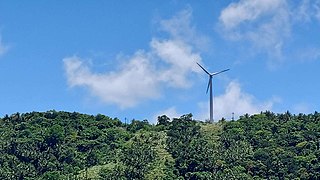
The electricity sector in Canada has played a significant role in the economic and political life of the country since the late 19th century. The sector is organized along provincial and territorial lines. In a majority of provinces, large government-owned integrated public utilities play a leading role in the generation, transmission, and distribution of electricity. Ontario and Alberta have created electricity markets in the last decade to increase investment and competition in this sector of the economy.

Huxley Hill Wind Farm is a wind power station at King Island, Tasmania, Australia, of around 1600 residents, owned by Hydro Tasmania, which supplements the four diesel generators with a combined capacity of 6 MW at Currie Power Station. King Island also has a 100 kW solar capacity provided with monocrystaline solar panels on dual-axis arrays.

Wind power is a branch of the energy industry that has expanded quickly in the United States over the last several years. From January through December 2023, 425.2 terawatt-hours were generated by wind power, or 10.18% of electricity in the United States. The average wind turbine generates enough electricity in 46 minutes to power the average American home for one month. In 2019, wind power surpassed hydroelectric power as the largest renewable energy source in the U.S.
Wind power has a history in Canada dating back many decades, particularly on prairie farms. As of December 2021, wind power generating capacity was approximately 14,304 megawatts (MW). Combined with 2,399 MW of solar power generating capacity, this provided about 6.5% of Canada's electricity demand as of 2020. The Canadian Wind Energy Association (CanWEA) has outlined a future strategy for wind energy that would reach a capacity of 55 GW by 2025, meeting 20% of the country's energy needs.

Biglow Canyon Wind Farm is an electricity generating wind farm facility in Sherman County, Oregon, United States. It is owned by Portland, Oregon-based Portland General Electric and began operations in 2007. With the completion of phase 3 of the project it has a generating capacity of 450 megawatts. It is located roughly five miles (8 km) northeast of Wasco, Oregon, and about ten miles (16 km) southeast of Rufus, Oregon. Biglow Canyon Wind Farm covers 25,000 acres (10,000 ha) in the Columbia River Gorge.

The Shiloh wind power plant is a wind farm located in the Montezuma Hills of Solano County, California, USA, close to Bird's Landing and Collinsville, 40 miles (64 km) northeast of San Francisco. It has a nameplate capacity of 505 megawatts (MW) of power and was built in four stages between 2005 and 2012. Several additional projects are also located in the Montezuma.

Community wind projects are locally owned by farmers, investors, businesses, schools, utilities, or other public or private entities who utilize wind energy to support and reduce energy costs to the local community. The key feature is that local community members have a significant, direct financial stake in the project beyond land lease payments and tax revenue. Projects may be used for on-site power or to generate wholesale power for sale, usually on a commercial-scale greater than 100 kW.

Renewable energy in Canada represented 17.3% of the Total Energy Supply (TES) in 2020, following natural gas at 39.1% and oil at 32.7% of the TES.
Port Alma Wind Farm is a large wind farm project located on the north shore of Lake Erie in the Municipality of Chatham–Kent, Ontario, Canada.

St. Leon Wind Farm is Manitoba's first wind farm, in St. Leon, Manitoba, Canada. In the first phase completed in 2006, 63 wind turbines were erected over a 93-square-kilometre (36 sq mi) area, capable of delivering 99 megawatts (MW). In 2011 a further 10 turbines were purchased, expanding the capacity of the project to 120 megawatts.

Capital Power is a North American independent power generation company based in Edmonton, Alberta, Canada. It develops, acquires, owns and operates power generation facilities using a variety of energy sources.

A tidal stream generator, often referred to as a tidal energy converter (TEC), is a machine that extracts energy from moving masses of water, in particular tides, although the term is often used in reference to machines designed to extract energy from the run of a river or tidal estuarine sites. Certain types of these machines function very much like underwater wind turbines and are thus often referred to as tidal turbines. They were first conceived in the 1970s during the oil crisis.

Renewable energy in Taiwan contributed to 8.7% of national electricity generation as of end of 2013. The total installed capacity of renewable energy in Taiwan by the end of 2013 was 3.76 GW.
Independent power producer (IPP) projects have had a significant presence in British Columbia since the 1980s. Their relationship with BC Hydro grew from the province's need to supply growing energy demands and implementation of the 2002 Energy Strategy, which mandated that BC Hydro would purchase its energy supply from IPPs rather than generating the supply itself. There are a variety of power projects in BC, with the most popular being hydroelectricity and biomass projects. In recent years, more attention has been placed on the environmental effects of IPP projects and the social implications it has to residents living around the project development sites. Despite the decline in demand for new IPP projects, in 2016 they supplied 20,000 GWh, one-third of BC Hydro's total.

Romblon Wind Farm is a wind farm in Romblon, Romblon, Philippines. The wind farm uses three units of 41.5-meter (136 ft) high Komaihaltec KWT300 wind turbines erected on the hills of Barangays Agnay, Bagacay and Lonos in Romblon, Romblon. The wind farm is a project of Romblon Electric Cooperative (ROMELCO) and was made possible through a funding grant from Japanese companies Komaihaltec Inc. and Honda Motor Co. Ltd. The wind turbines were erected in 2018 and began operation in 2019. Under the contract between ROMELCO, Komaihaltec Inc., and Honda Motor Co. Ltd., the wind farm will be turned over to ROMELCO in 2023 after a four-year demonstration period.
















